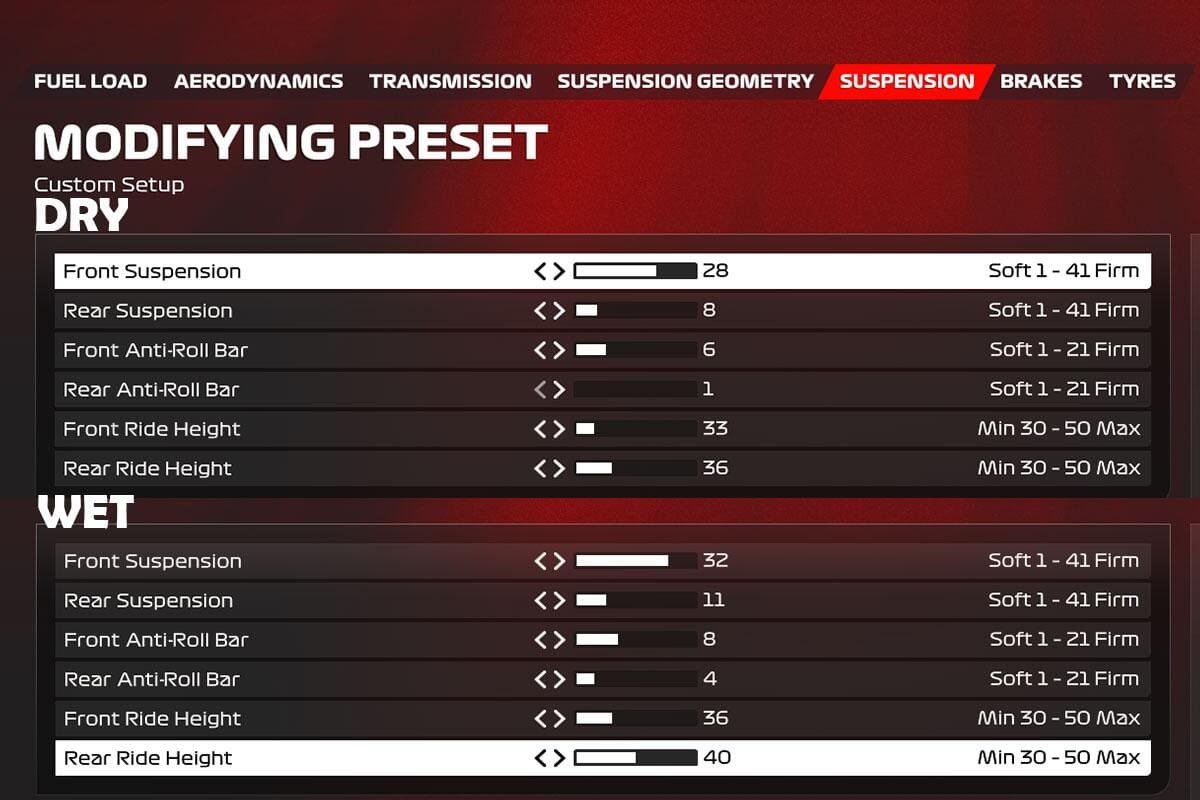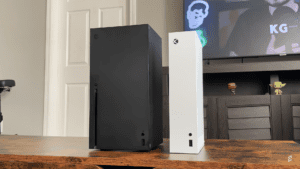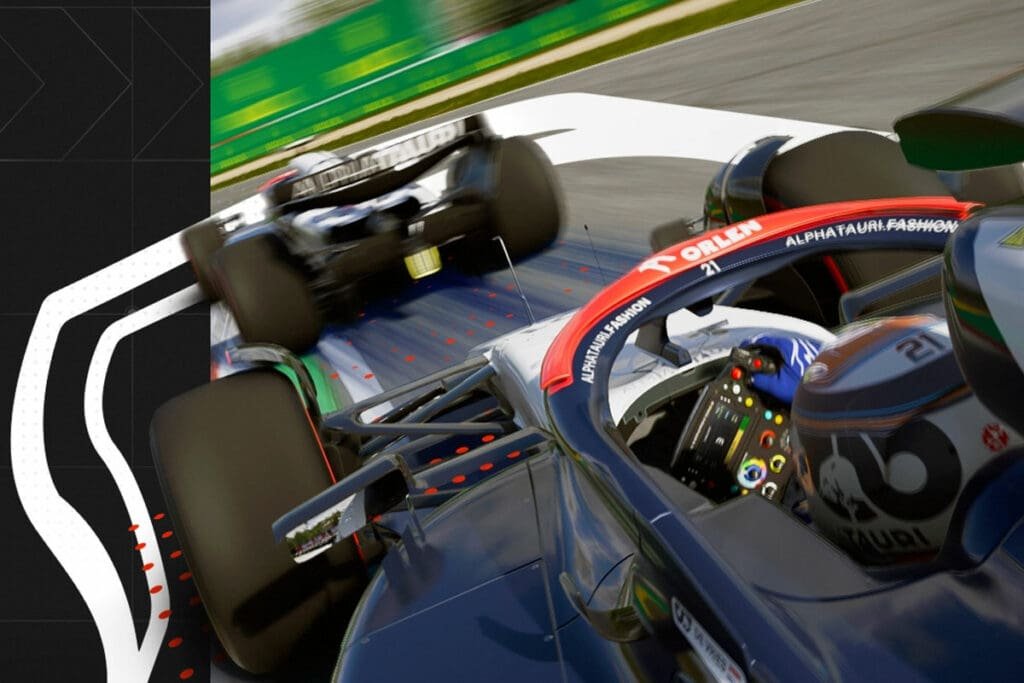Formula 1 is a sport that has always been about speed, precision, and strategy. This carries into the video game as well, your F1 23 car setups play a crucial role in determining the performance of your car on different tracks. In this article, we will provide you with the ultimate guide on building setups by showing you how to set the values in each category for every track.
What are F1 23 car setups and why are they important?

Before we dive into the details of the car setups, let’s first understand what they are. In simple terms, car setups are the adjustments made to a Formula 1 car to optimize its performance on a specific track. These adjustments can be made to various components of the car, like aerodynamics, transmission, suspension, brakes, and tyres. The goal is to find the right balance between speed and control, depending on the characteristics of the track.
F1 23 car setups are crucial because they can potentially make the difference between a podium finish and a lost race. A well-optimized car setup can give you a significant advantage over your competitors, both in terms of speed and handling. The right setup will also help you conserve your tires, reduce fuel consumption, and avoid unnecessary pit stops.
An overview of all settings and how they affect your F1 23 car setups

Getting the right car setup in F1 23 can be a daunting task, but with the right approach, it can be achieved. Here’s a step-by-step guide on how to get your car setup settings right:
Aerodynamics
This category of settings affects the downforce and drag of your car. Downforce helps you corner faster, while drag slows you down. The best aerodynamic settings for a track will depend on the number of corners and straights on it.
A track with a lot of corners will require more downforce (30-45), while a track with a lot of straightaways will require less downforce (20-35). However, remember to never go to the full extreme values on either side. You can also consider keeping the front wing aero higher than the rear for better turnability on tracks that require quick sharp turns.
Transmission
The differential lock affects how much the wheels on each axle are allowed to spin at different speeds. The optimal differential settings will depend on the amount of cornering required on the track.
For example, a track with a lot of tight corners will require a more locked differential, while a track with a few wide corners will require a more open differential. For F1 23 Car setups though, going for an open differential (lower value, 50-65) works best for both on and off throttle. Keeping both under 60 is advisable.
Suspension Geometry
These settings in the car setup affect the angle at which your tyres are aligned. Camber is what decides how much your tyre is angled inwards or outwards when viewing from the front. A more negative value on the camber will cause the wheels to come in contact with the track more while cornering and a more positive one will do the opposite. While this can improve handling, it comes at the cost of increased tyre wear.
The toe affects how much your tyres point inwards or outwards when viewed from the top. The optimal settings for most tracks require a high toe-out on the front tyres while a high toe-in on the rear. These can be further adjusted based on how many bumps and banked corners a track has.

Suspensions
The roll stiffness affects how the car shifts its weight when cornering. The optimal suspension setup for a given track will depend on the track surface and the amount of grip available. For example, a track with a smooth surface will require a softer suspension, while a track with a rough surface necessitates a stiffer suspension. When it comes to the anti-roll bars or ARBs, stiffer rear ARBs (higher values) and softer front ARBs (lower values) will give you better responsiveness and give you less understeer. These can be further tuned based on different tracks and your racing style.
The ride height should be based on the elevation changes and other bumps on the track, a higher ride height will help you avoid bottoming out. Make sure your rear ride height is always higher to keep an optimal weight balance. The general advice here would be to keep ride height as low as possible.
Brakes
The brake bias affects how much braking force is applied to the front and rear brakes. the best brake settings for F1 23 car setups for a given track will depend on the amount of braking required on the track. For example, a track with many heavy braking zones will require a more rearward brake bias, while a track with a few light braking zones will require a more forward brake bias.
As a general rule of thumb, the brake pressure should always be set to 100% on all tracks. This should only be reduced if you are racing in wet conditions or if you have ABS turned off. Even still, you should not reduce this beyond 92% in F1 23 Car setups.
Tyres
This category of settings affects the performance of your tyres. The tyre pressures affect how much the tyres grip the track. But it can also increase or decrease how quickly your tyre wears.
The optimal tyre setup for a given track will depend on the track temperature and the amount of downforce on your car setup. But it requires long-term testing to see how much tyre wear you are really getting.
Difference between F1 23 Time Trial and Race setups

When building a setup, you first have to consider if the setup is going to be built for a race or a time trial. The reason is that both setups have to be made differently.
F1 23 car setups for Race
Race setups are not only made for performance but also consider efficiency and durability. These setups have to make sure the car can perform well while keeping the tyre wear low. Things like having higher tyre pressure are crucial for race durability.
Many of the settings in a setup can give more performance and speed but it comes at the cost of tyre wear. The more tyre wear you take, the more pit stops you will need which can make you lose the race.
F1 23 car setups for Time Trial
Time trial setups are designed for maximum performance throughout. These are made without the worry of tyre wear because not only do you have to use them for only a short amount of time, but you also don’t have any tyre temperature concerns in this mode as they are turned off.
While building for this mode is easier and more straightforward, racing an F1 car using said setup, on the other hand, can prove to be a mighty challenge. This is because they use the maximum potential of an F1 car and require a lot of skill to handle. Time trial setups are also made for qualifications when playing the career mode.
Best F1 23 car setups for all tracks

Here are the best setups for each track in F1 23 which you can use as a base and further tune based on your own preferences:
- Bahrain – Bahrain International Circuit: Fast, flowing track with long straights as well as high- and low-speed corners.
- Saudi Arabia – Jeddah Corniche Circuit: Demanding street track with long straights, high-speed corners, and a narrow layout.
- Australia – Albert Park Circuit: Historic track with a mix of fast and slow corners, and a typical long straight, a nice challenge to create your own F1 23 car setups.
- Azerbaijan – Baku City Circuit: Beautiful street circuit with challenging temperature conditions and a tight hairpin.
- Miami – Miami International Autodrome: New American street circuit with a decent mix of fast and slow corners, and a long straight.
- Imola (Italy) – Imola Circuit: Historic F1 track with a mix of fast and slow corners, and a challenging chicane.
- Monaco – Circuit de Monaco: Iconic street circuit with a narrow layout, tight corners, elevation changes, and a tunnel.
- Spain – Circuit de Barcelona-Catalunya: Technical track which features all types of corners and straights, demands the most from your F1 23 car setups.
- Canada – Circuit Gilles Villeneuve: Fast, challenging track with the typical long straight combined with skillful turns.
- Austria – Red Bull Ring: Fast, flowing track with a minimal number of turns, challenging weather, and surface conditions.
- Britain – Silverstone Circuit: Historic British track with a mix of fast and slow corners, and a long straight.
- Hungary – Hungaroring: Technical track with a regular mix of high- and low-speed corners, and a long straight.
- Belgium – Circuit de Spa-Francorchamps: Fast, challenging track with multiple elevation changes and hairpin turns.
- Netherlands – Circuit Zandvoort: All-rounder track featuring fast long turns, demands the most out of your F1 23 car setups.
- Monza (Italy) – Monza Circuit: Fast, historic track with a long straight and a challenging chicane.
- Singapore – Marina Bay Street Circuit: Night race on a street circuit with the typical mix of fast and slow corners, and a long straight.
- Japan – Suzuka International Racing Course: Iconic Japanese race circuit that is loved by the F1 fans, features tough corners and speedy straights.
- Qatar – Lusail International Circuit: A new track to master in F1, featuring a technical track that requires high skill.
- United States – Circuit of the Americas (COTA): Fast, technical track that is known to bring the American audience into the F1 racing culture, features sharp turns and multiple DRS zones.
- Mexico – Autódromo Hermanos Rodríguez: A tough and challenging track that every F1 racer looks forward to during the season with its unique layout and structure.
- Brazil – Interlagos Circuit: A historic Brazilian track that is beloved by F1 fans and provides a decent challenge for building F1 23 car setups.
- Las Vegas – Las Vegas Street Circuit: New street circuit with a mix of fast and slow corners, and a long straight.
- Abu Dhabi – Yas Marina Circuit: Night race on a street circuit with a narrow layout that promotes high speed and good control.
- Portugal – Algarve International Circuit (Bonus track): A typical fast, flowing track with a decent mix of high- and low-speed corners, also loved by the fans.
- China – Shanghai International Circuit (Bonus track): State-of-the-art track with long straights and high radius turns with few sharp turns.
- France – Circuit Paul Ricard (Bonus track): Speedy track that tests the speed potential of your F1 car and builds.
Learning how to make the best F1 23 car setups that work best for you can be extremely rewarding. Even if you are not into technical aspects, using our recommended setups for each track will surely help you muster better understanding for all the nitty-gritty of your Formula One wheels.





